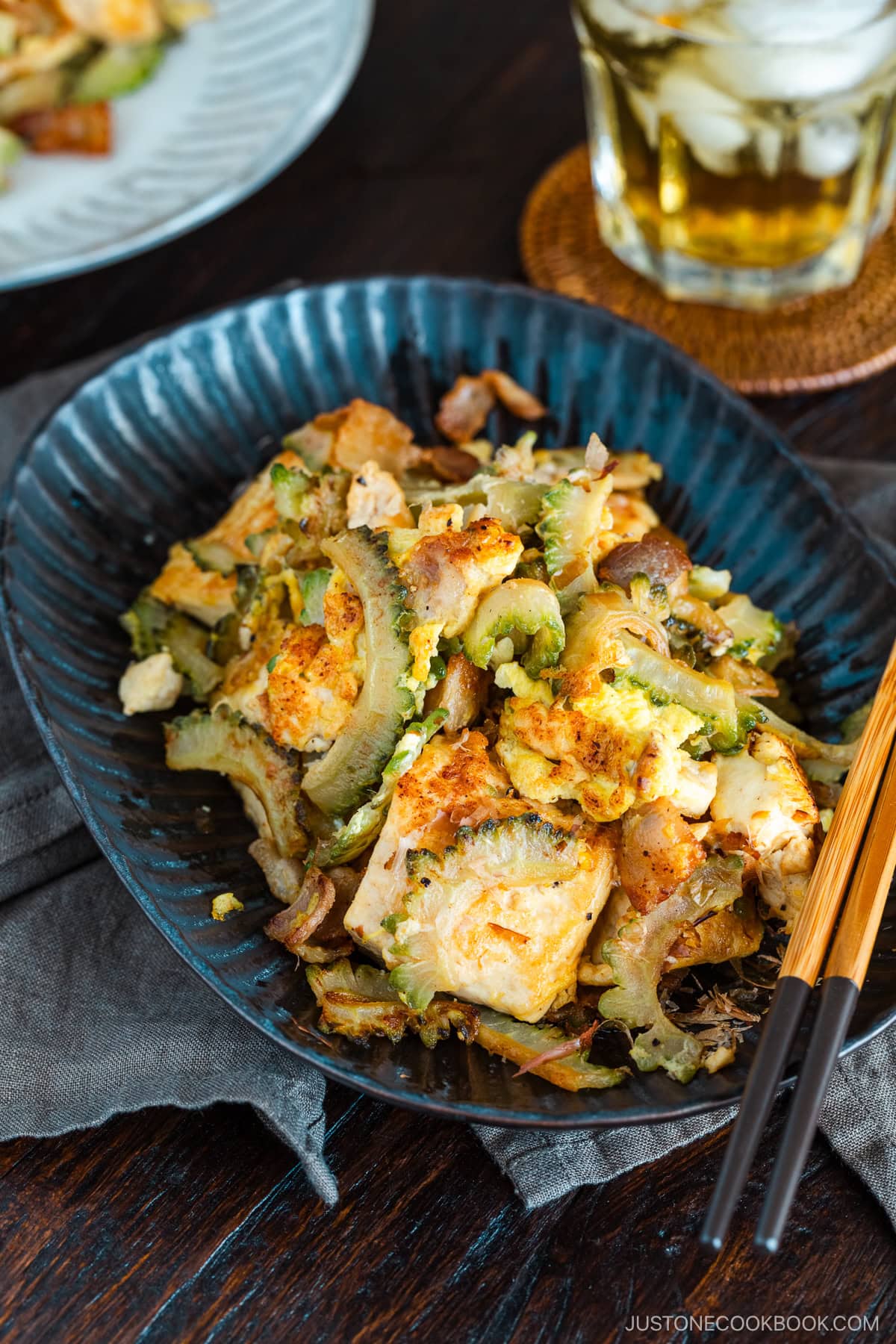
Goya Champuru (ゴーヤチャンプル) is a popular stir fry dish that came from the sunny island of Okinawa in southern Japan. Made with vibrant green bitter melon, tofu, pork belly, and egg, it is packed with protein and nutrients.
As I am planning my first trip to Okinawa this winter, I am excited to discover many more delicious Okinawan dishes. But first, let me introduce this simple yet absolutely healthy home-cooked dish of Okinawa – Goya Champuru with you.
What is Goya Champuru?
Goya (ゴーヤ) is an Okinawan dialect of Nigauri (にがうり). In English, it’s bitter melon or bitter gourd. As you can probably guess, bitter melon is famous for its bitterness, but it is remarkably nutritious.
Chanpurū (チャンプルー) refers to Okinawan stir-fry dishes, meaning “something mixed” in Okinawan. Stir-fry dishes are a big part of Okinawan cuisine. There are different types of champuru. Usually, it contains tofu with some kind of vegetables, meat, or fish. Common ingredients include spam, pork, egg, bean sprouts, and bitter melon. Spam is not typically used in mainland Japan, but Okinawan cuisine uses spam due to the influence of the US Navy.
Growing up in Yokohama (Tokyo area) between the ’70s and ’90s, Okinawan restaurants were rare to find and I had never had a chance to try Okinawan dishes.
Through the NHK TV drama “Churasan” (ちゅらさん) broadcasted in 2001, many people became interested in Okinawan culture and visited Okinawa on vacation. The popularity of Okinawan food spread all over mainland Japan, and we started seeing more Okinawan restaurants everywhere. Even Japanese housewives started to cook Okinawan dishes at home.

5 Health Benefits of Bitter Melon
- Treats skin conditions. Bitter melon juice has powerful antioxidants with Vitamin C and A, which prevent premature skin aging, diminish wrinkles, reduce acne, and help in treating eczema. The amount of vitamin C in bitter melon is four times more than in lemon and five times more than in tomatoes. Usually, vitamins get lost by being cooked, but not for bitter melon, which is why it’s perfect to cook Goya Champuru
- Lowers bad cholesterol levels. Studies have shown that the juice from bitter melon significantly reduces the risk of heart attack and stroke and keeps the heart healthy.
- Helps maintain blood sugar levels. Studies have also shown that eating bitter melon on a regular basis significantly reduces the blood sugar level for patients suffering from type-1 and type-2 diabetes.
- Prevents cancer. Those bitter flavors contain components that reduce blood sugar levels and cholesterol. Studies have also shown positive correlations between eating bitter melon and preventing or reducing tumor growth in cervical, prostate, and breast cancer patients.
- Boosts your immune system. Bitter melon is a source of many different antioxidants that make it a powerful defense mechanism against illnesses in the body.
How to Choose the Bitter Melon
Bitter melon season in Japan is from July to September. These days, bitter melon is also available at farmers’ markets or Asian grocery stores in the US. For the best taste, choose bitter melon in a relatively smaller size with lots of bumps. The surface should be fresh and shiny green, and you want to pick one that feels firm to the touch.
How to Store the Bitter Melon
To keep bitter melon fresh for a longer time, remove the seeds and pith first as they go bad quickly. Make sure you remove the inner white pith clean as that’s where the bitterness most concentrates. After slicing, you can store them in an airtight container in the refrigerator for later use.
How to Reduce Bitterness of the Bitter Melon
I learned to sprinkle some salt, but I also heard that enhances the bitterness instead. Some suggest cooking in lightly salted boiling water, then again I heard the method also causes bitterness. I assume everyone’s grandma suggests different things and you just need to try out the method that works for you. I use the salt method as it draws out moisture with some bitter flavors.
This amazing gourd may have an acquired taste, but there are plenty of good reasons to eat it. In this homey Okinawan stir fry, crunchy crisp bitter melon is combined with soft creamy tofu and cooked in a delicious umami-rich dashi and soy sauce seasoning. It’s truly a healthy and everyday meal you can serve for the family. I’d like you to give it a try.
Do you have any experience cooking with bitter gourd (goya)? What are your favorite ways of cooking with it? How do you remove the bitterness of the gourd? Share with us in the comment below!
Other Bitter Melon Recipe

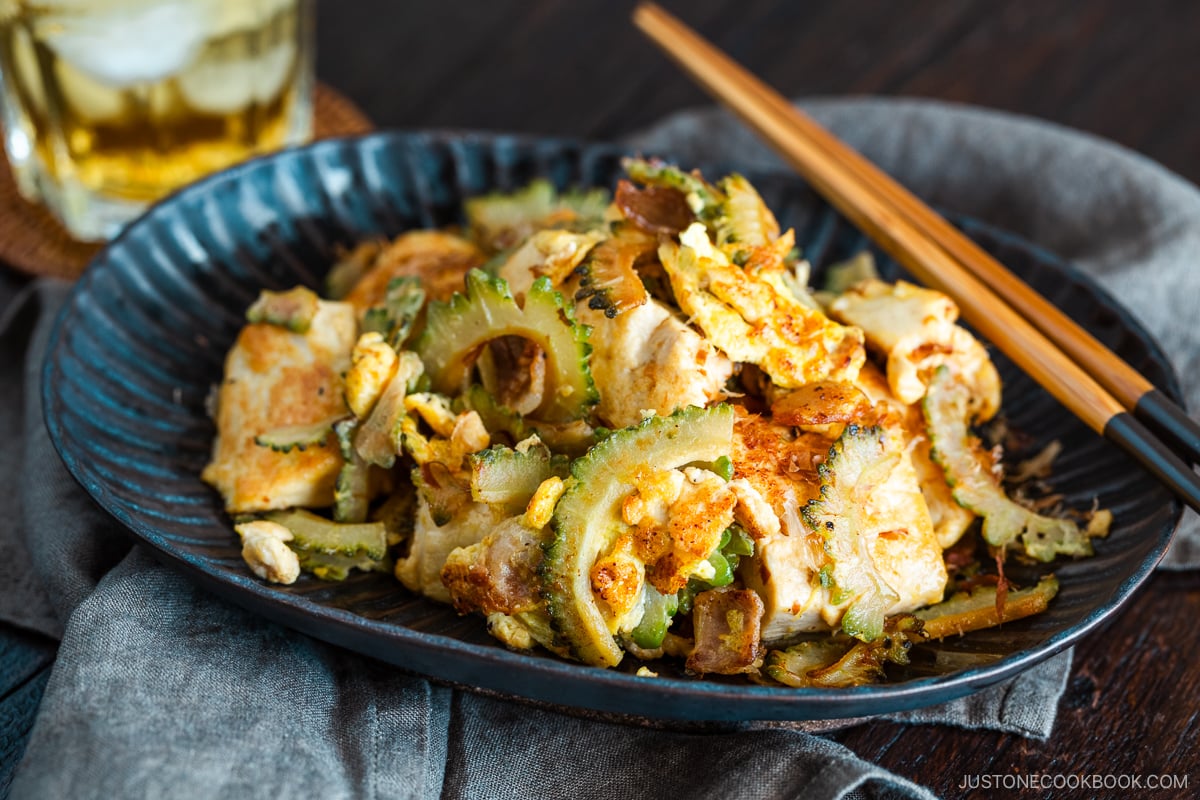
Wish to learn more about Japanese cooking? Sign up for our free newsletter to receive cooking tips & recipe updates! And stay in touch with me on Facebook, Pinterest, YouTube, and Instagram.
Goya Champuru
Ingredients
- 1 bitter melon (8 oz, 227 g)
- 1 tsp Diamond Crystal kosher salt (for the bitter melon)
- 14 oz medium-firm tofu (momen dofu)
- 6 slices sliced pork belly
- 2 large eggs (50 g each w/o shell)
- 2½ Tbsp neutral oil (divided; to fry the tofu, bitter melon, and pork)
- ¼ tsp Diamond Crystal kosher salt
- ⅛ tsp freshly ground black pepper
- 1 Tbsp soy sauce
For the Katsuo Dashi
- 3 Tbsp katsuobushi (dried bonito flakes) (I use 1 (3 g) packet and more for garnish)
- ¼ cup boiling water (4 Tbsp)
Instructions
- Gather all the ingredients.
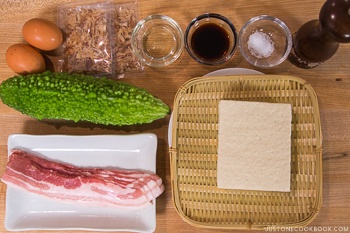
To Prepare the Ingredients
- First, make the katsuo dashi. Add 3 Tbsp katsuobushi (dried bonito flakes) into a measuring cup and add ¼ cup boiling water. Let it steep until you’re ready to cook. Right before you start cooking, strain and remove the katsuobushi (you can reserve it to make Homemade Furikake Rice Seasoning). Tip: Alternately, you could use a dashi packet or dashi powder in a pinch or Vegan Dashi for vegan/vegetarian.

- Cut 1 bitter melon in half lengthwise. Using a spoon, scrape out the seeds and inner white pith.
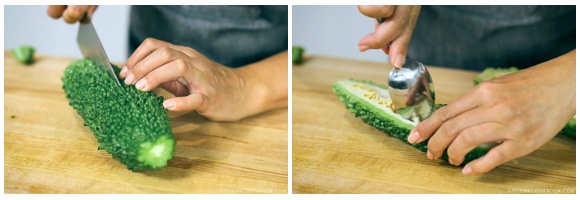
- Thinly slice the bitter melon crosswise about ⅛ inch (3–4 mm) thick. Sprinkle 1 tsp Diamond Crystal kosher salt and toss well. Let stand for 10 minutes.

- Meanwhile, wrap 14 oz medium-firm tofu (momen dofu) with a paper towel. Place a heavy flat object, like a cutting board, on top of the tofu to squeeze out the water. I use flat trays to sandwich the tofu and place a marble mortar on top.

- After 10 minutes, quickly rinse the bitter melon with water and drain well. I use a salad spinner to get rid of the moisture easily.

- Cut your 6 slices sliced pork belly into 1½-inch (3.8-cm) pieces.

- Beat 2 large eggs (50 g each w/o shell) in a medium bowl. Now, tear the drained tofu with your hands into bite-size pieces.
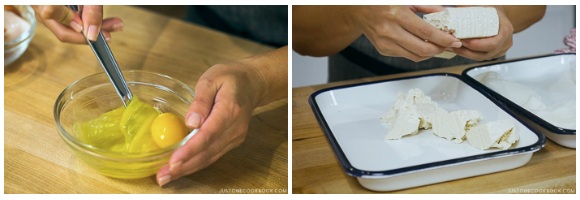
To Cook
- Heat a large frying pan and add 1 Tbsp neutral oil. Put the tofu in the pan.

- Try not to touch the tofu frequently. Cook until the tofu is browned and the moisture has evaporated. Transfer to a plate.
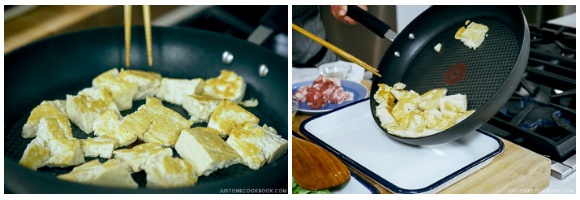
- Add 1 Tbsp oil to the same frying pan. Add the bitter melon and spread it out in the pan.
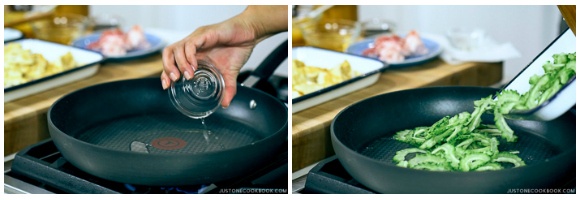
- Sprinkle with 1 pinch kosher salt and stir-fry until almost cooked. Transfer to a plate.
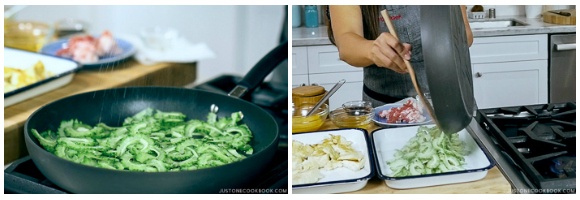
- Add ½ Tbsp oil to the pan and add the pork belly. Season with 1 pinch kosher salt and ⅛ tsp freshly ground black pepper. Stir-fry until nice and golden brown.

- Add the bitter melon and the tofu back into the frying pan.
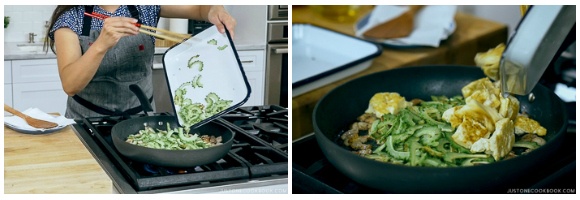
- Add the katsuo dashi and 1 Tbsp soy sauce. Let the liquid evaporate while you toss to combine.
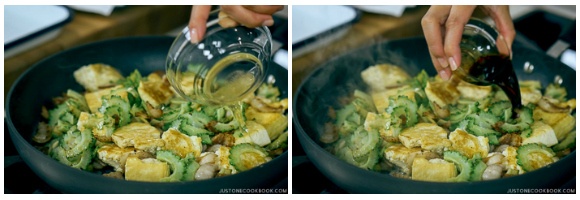
- Taste the dish. Add kosher salt and freshly ground black pepper, if necessary. Use salt to enhance the flavor instead of adding soy sauce.
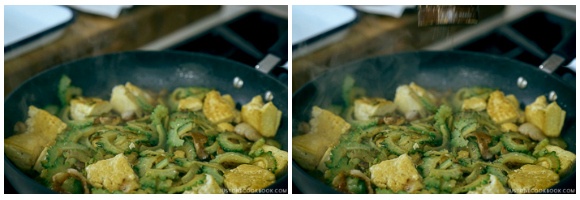
- Add the beaten eggs to the frying pan and shake it to cook the egg. Once the egg is no longer runny, turn off the heat.
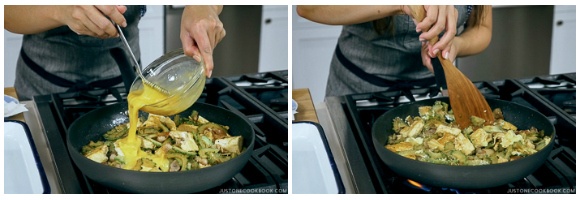
To Serve
- Transfer to a serving plate and sprinkle with more katsuobushi (bonito flakes). Enjoy!
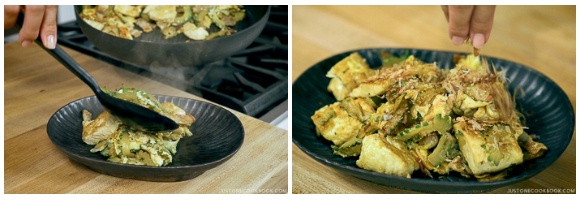
To Store
- You can keep the leftovers in an airtight container and store in the refrigerator for up to 3 days or in the freezer for a month.
Nutrition
Did you make this recipe?
Tag @justonecookbook on Instagram so we can see your delicious creation!



